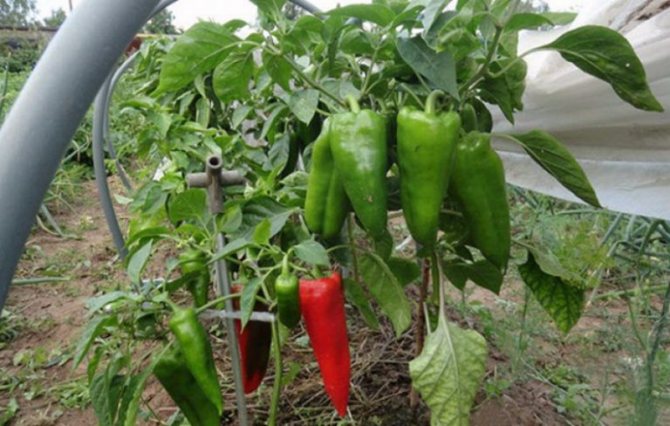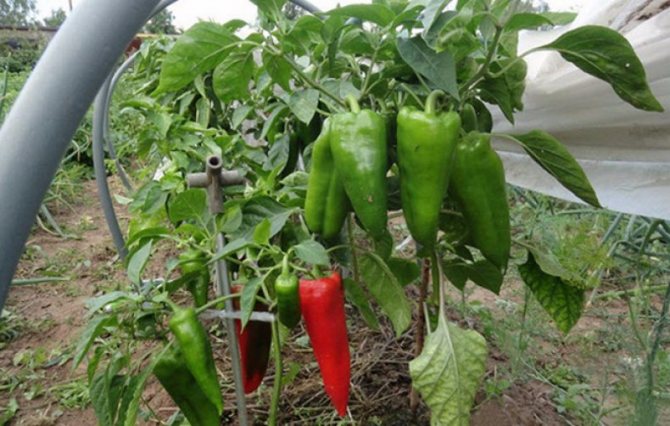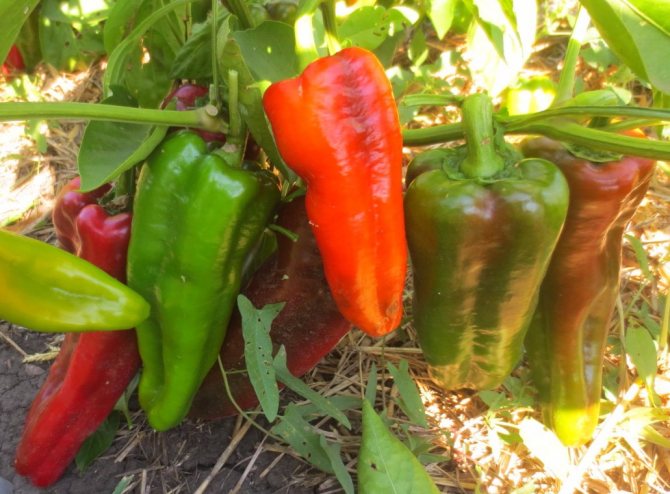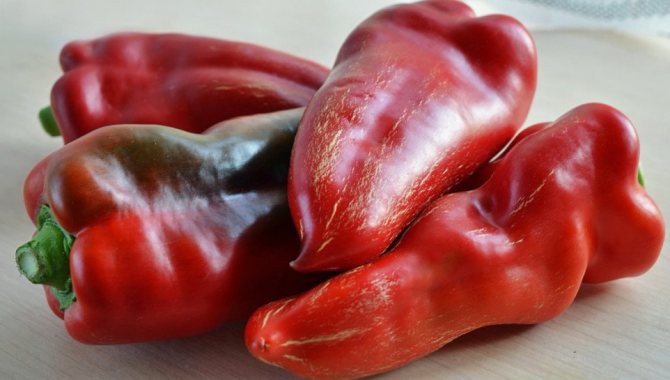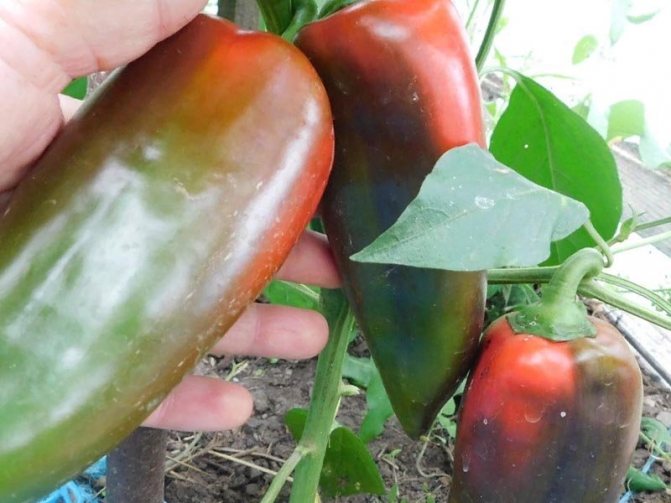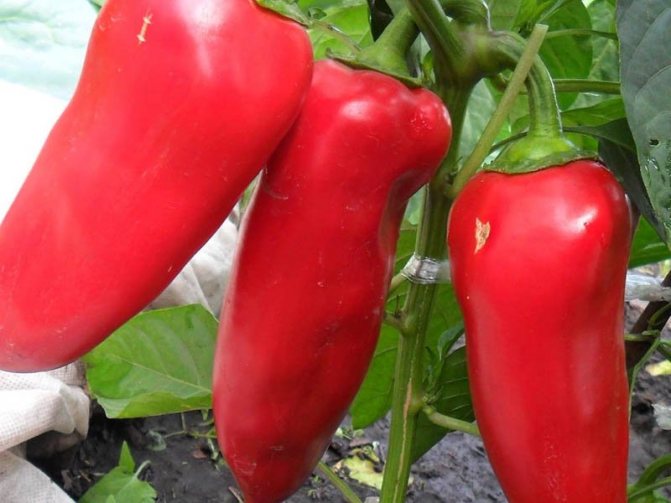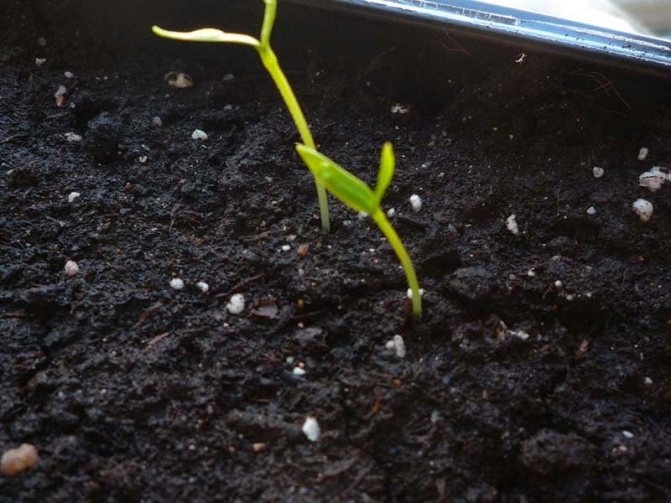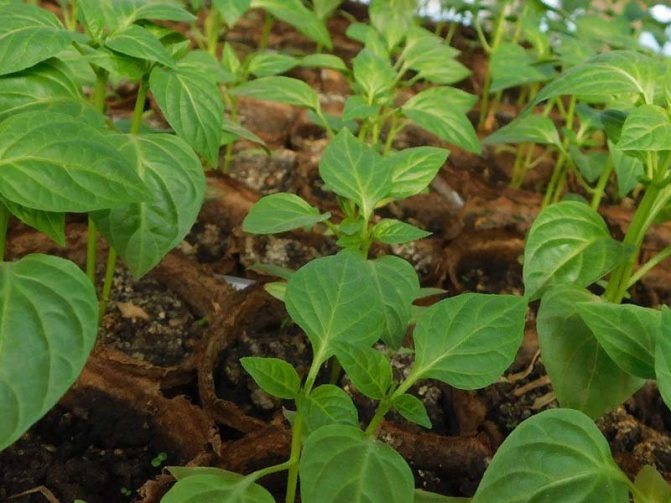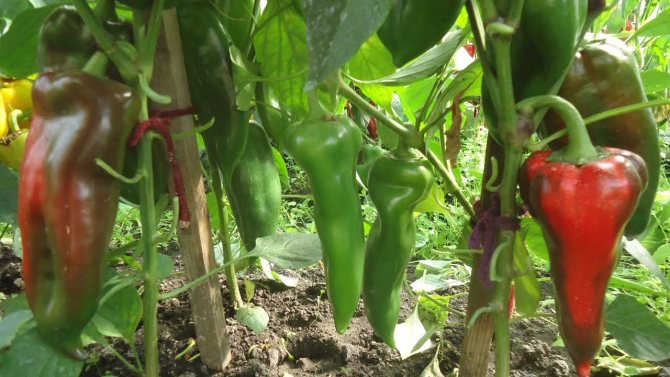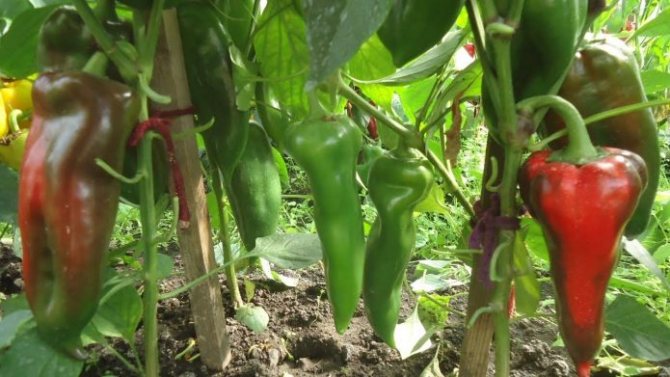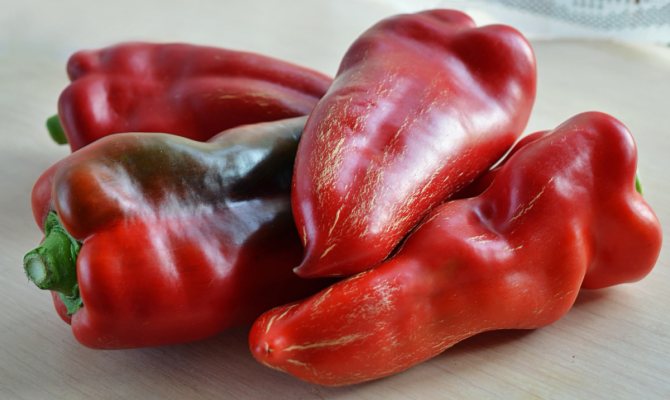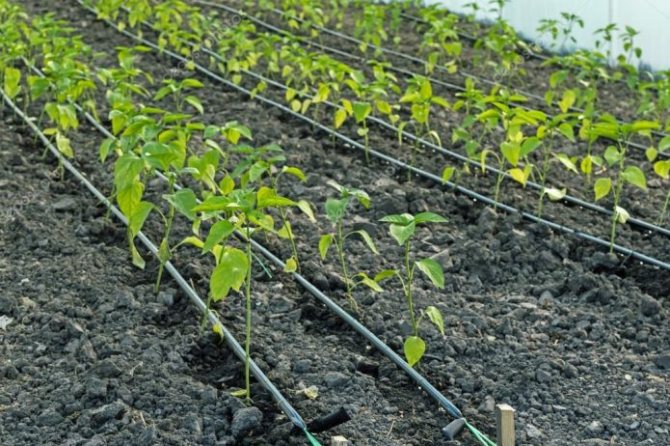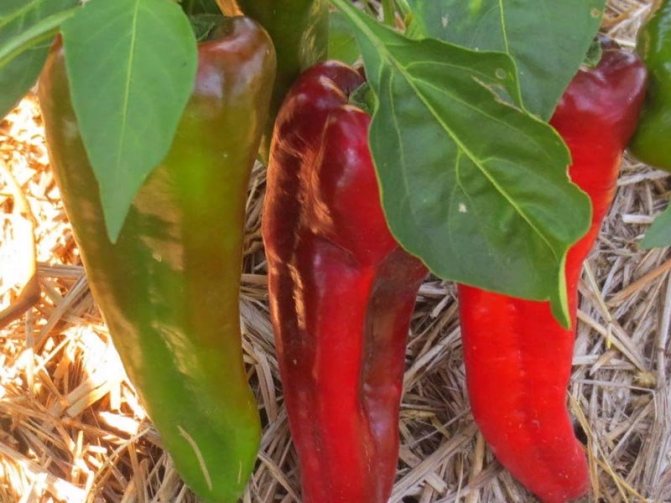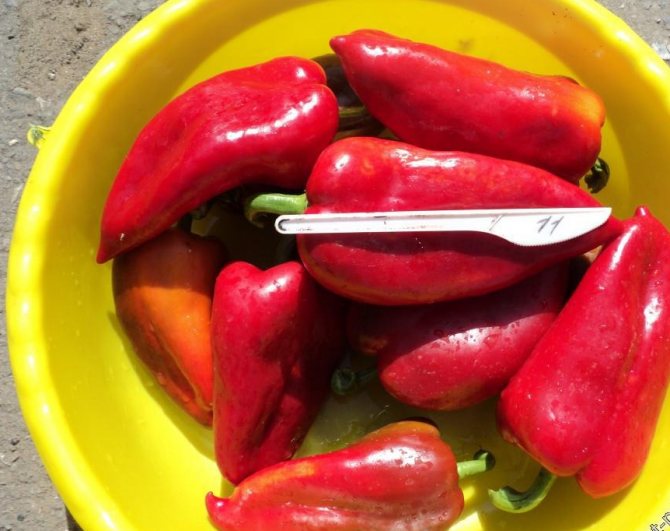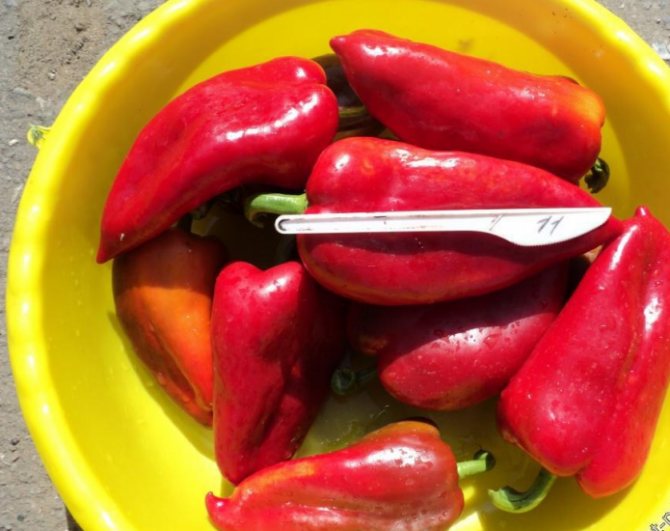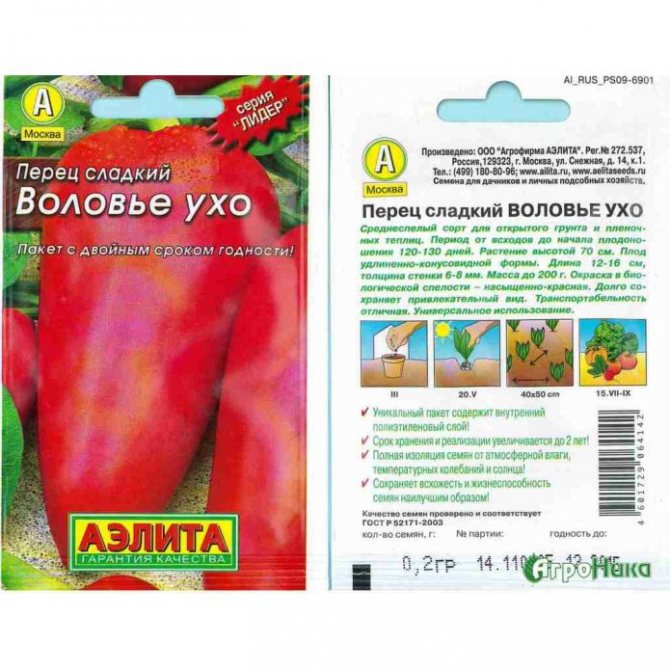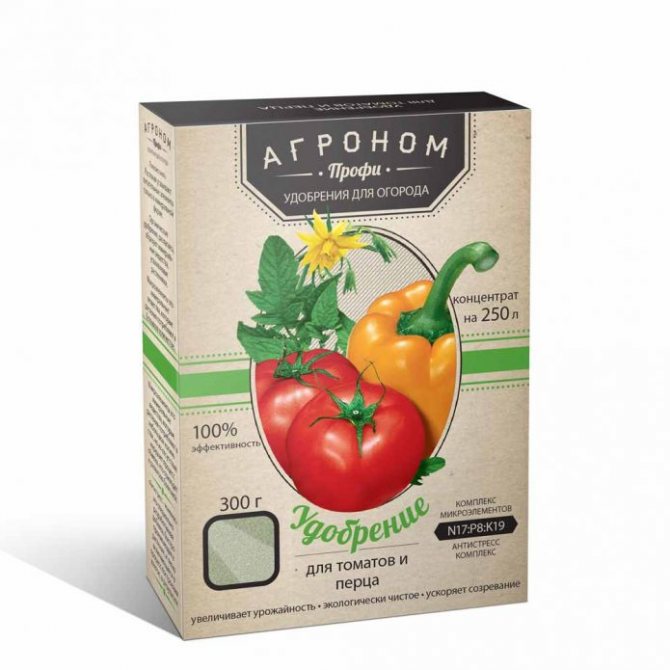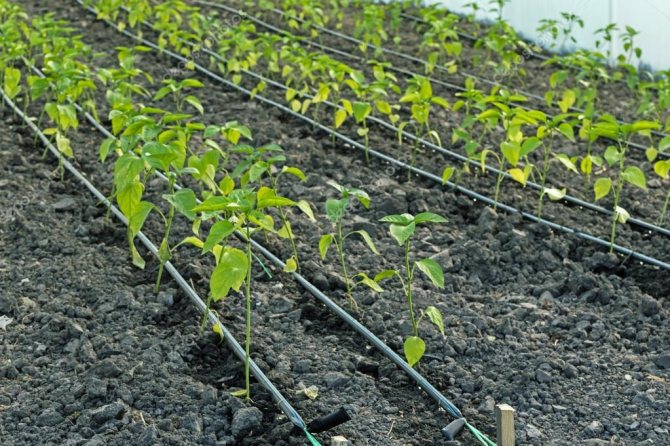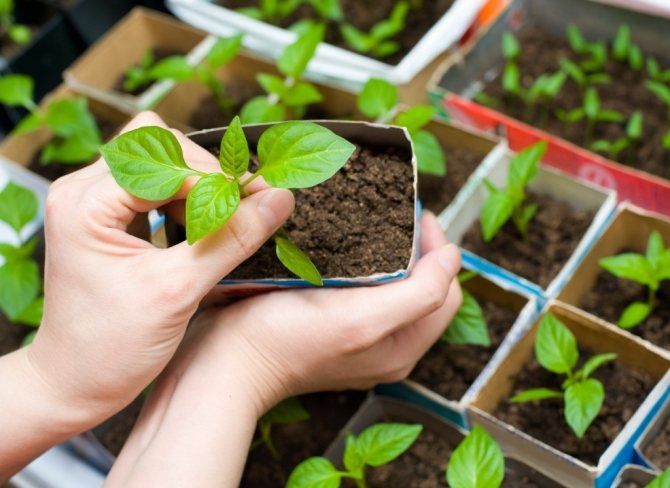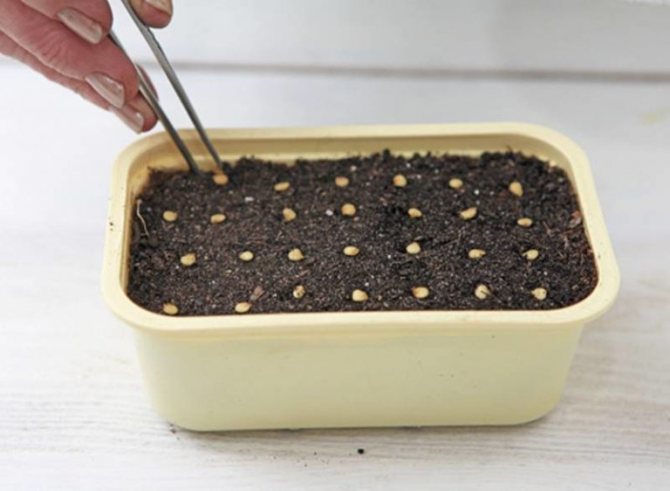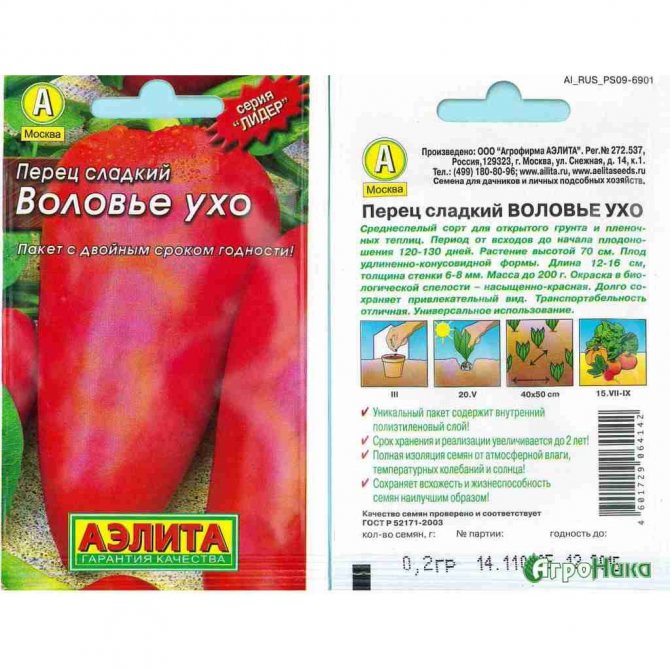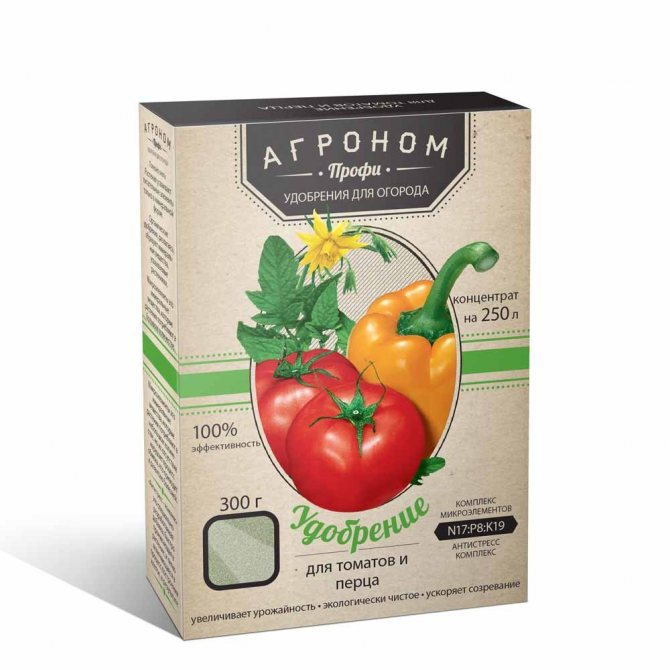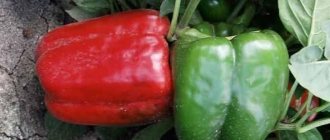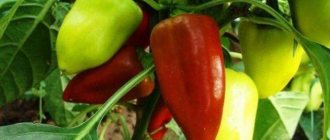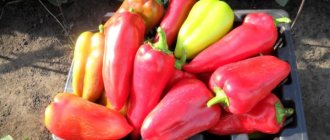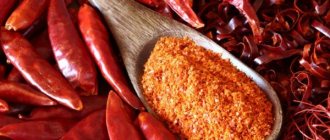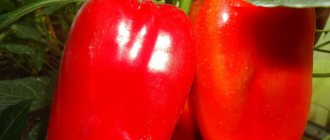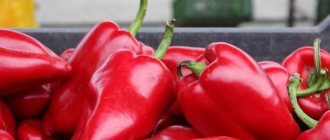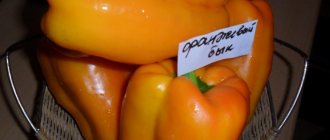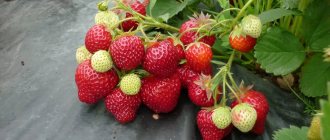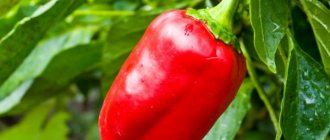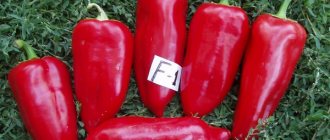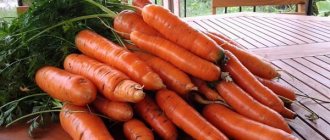Sweet pepper is considered one of the most common vegetable crops in vegetable gardens. This vegetable has long won the love of the population. Even laborious plant care does not stop summer residents. This is due to the fact that peppers from their garden have amazing taste and nutritional qualities. There is a huge variety of choices among the varieties of this crop. They all differ in their individual characteristics. But there is a list of the most popular varieties. Pepper Volovye ear is one of them, and we will tell about it.
Description and photo
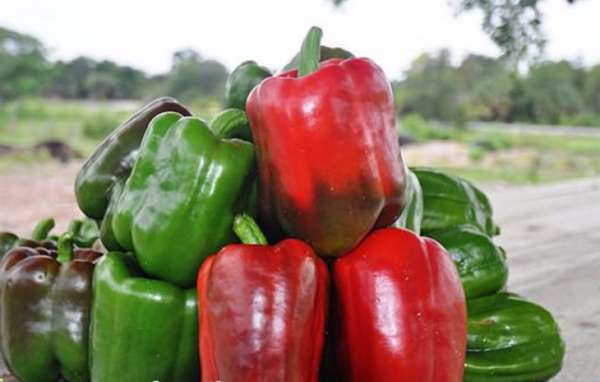
The variety "Volovy Ukha" has medium-sized bushes with a dense stem, branched foliage and reaches no more than 70 cm in height.
In this variety, the fruits are elongated, cone-shaped, corrugated and shaped like an ox's ear, which is why they got their name. The size of the ripe pepper is quite large, on average it reaches 12-16 cm.
In an immature state, the color of the fruit is dark green, and when ripe, it is bright red with a glossy sheen. Below is a photo.
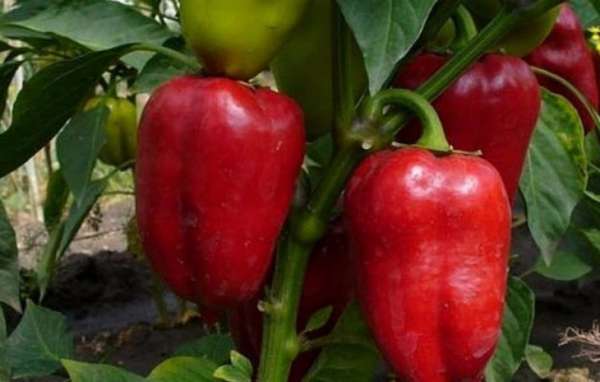

What's interesting?
The variety is adapted for all regions of Russia. In cool climates, Ox's Ear Peppers can be grown easily in greenhouses. In the Krasnodar Territory, it grows well in the open field.
Peppers of this variety are interesting, first of all, for their wonderful taste, which the breeders achieved in the process of work. The fruits of the Ox's ear are very large - up to 16 cm in length. There are so many of them on the bush that the plant has to be tied up during the ripening period.
Due to the dense, thick skin, the crop is perfectly stored, it is convenient to transport it. A cow is not a hybrid, therefore, by allowing it to mature to the end, you can collect seeds for next year on your own.
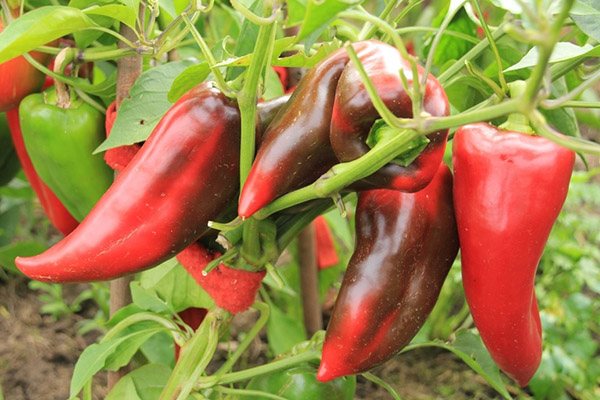

Characteristics of the variety
Mid-early (mid-season) variety with very sweet, juicy, dense and fleshy fruits. The density of the walls of a mature fruit reaches 6 to 8 mm. The largest peppers weigh 200-250 g, but an average of 120-150 g is normal for a crop.
From one bush of the "Voloviy ear" the yield is 2-3 kilograms. Has resistance to wilting and tolerates transportation well. Ideal for both fresh salads and canning, keeps well when frozen.
Advantages and disadvantages
This variety has many advantages:
- ideal for both household and industrial cultivation;
- can be grown both in greenhouses and in the open field;
- high-yielding, up to 3 kg per bush;
- excellent taste, even in fruits of technical maturity (colored green);
- resistant to many diseases;
- perfectly preserved during transportation.
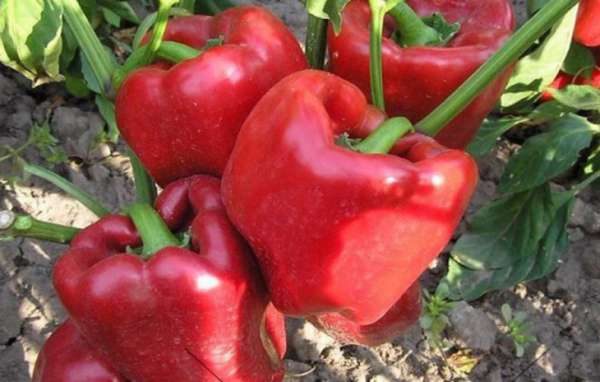

Among the disadvantages are:
- poor seed germination;
- does not tolerate a pick;
- does not like extreme heat and too low temperatures.
Care
Having transplanted seedlings into open ground, caring for it will consist in:
- loosening;
- watering;
- dressing;
- the formation of shoots;
- mulching.
Loosening is also called dry irrigation. However, for pepper, what is special is that it does not tolerate deep loosening, but only needs a superficial one, which destroys the crust.
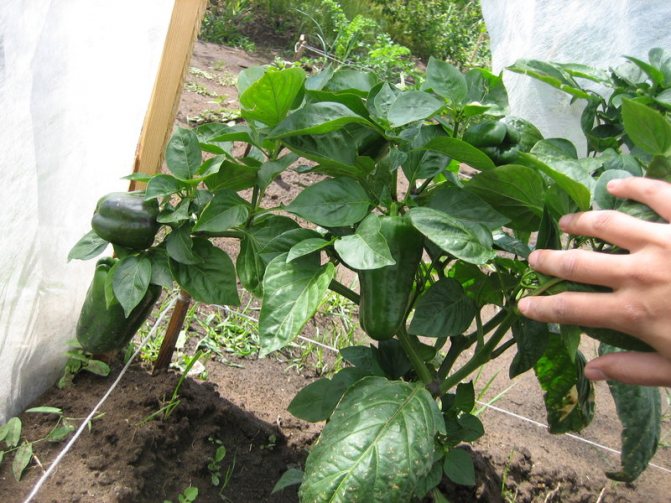

So that after watering the crust does not form, mulching is practiced. For this, you can use any natural or artificial material that prevents moisture evaporation.
Working with modern technologies, drip irrigation is very desirable, since pepper does not tolerate both strong waterlogging and drying out of the soil coma.
Considering the issue of fertilizing, carefully observe the condition of the plant. If the bush is too large, and there are few ovaries, it is overfed with nitrogen. If the strength of growth is not enough, then it is necessary to add 0.5 liters of a solution prepared with 2 tbsp for each bush. tablespoons of ammonium nitrate in a bucket of water.
The second feeding should be done during the period when the ovaries appear. To do this, in a bucket of water, you need to dilute 2 tbsp. tablespoons of superphosphate and pour 0.5 liters under each bush.
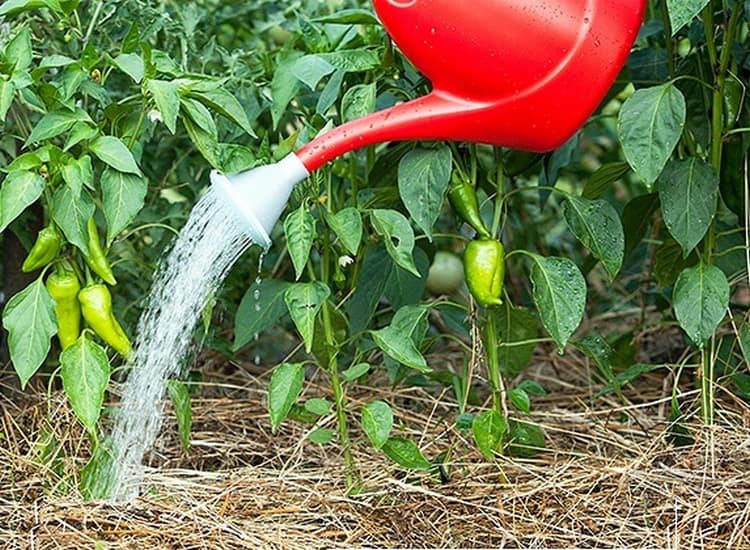

Excellent fertilizing, balanced in all elements, is obtained by diluting manure 1:10 or chicken droppings 1:20.
Landing features
The cultivation process of this variety will take 95-100 days from planting seeds or 70-75 days from planting seedlings in the ground. They are usually sown on March 10-20 in the soil prepared for seedling, planting seedlings - May 10-20, harvesting from July 25 to August 30. Seeds you need:
- pour water and take away those that remain at the bottom (do not float up containing sprouts);
- leave for a few days to swell;
- process with a weak solution of potassium permanganate;
- rinse with lukewarm water;
- plant 3-4 pcs. into prepared containers with a diameter of 3-4 cm (in boxes it is not recommended due to poor diving tolerance, since the root system is poorly developed);
- cover with foil and put in a warm place.
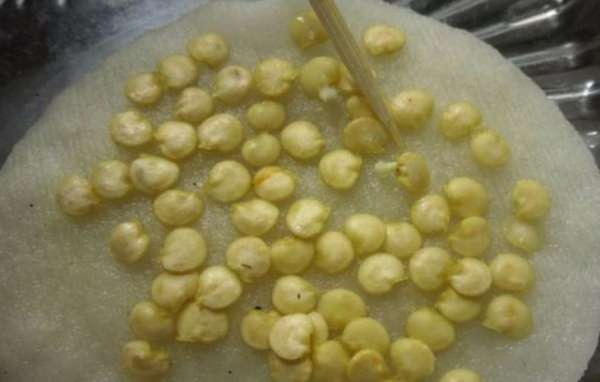

Planting seedlings in the ground has its own characteristics: due to the branching of the bushes, the distance between them should not exceed 50-60 cm. A favorable soil for planting will be fed with organic fertilizers or after the growth of green manure.
Growing rules
Cultivation is carried out only by the seedling method, therefore, it is necessary to prepare seedlings from the beginning of spring.
To sow the seeds, use the soil from the garden. It is not necessary to add other impurities to it. It is better to pour the soil into the seed containers, in which the seedlings will be planted in a permanent growing area. This trick is needed to reduce the stress level for the plant after planting in a permanent place.
Seed preparation
Seeds must be thoroughly prepared before planting. First of all, you need to select high-quality seeds that can sprout. For this, all the prepared planting material is placed in a container with water. All seeds that have floated to the surface are removed, because they do not have a special sprout that will allow them to emerge.
After that, the selected seeds are soaked in a solution of manganese or aloe juice. This is necessary to disinfect the planting material and remove all harmful bacteria. This allows you to speed up the germination process and reduce the number of possible diseases to a minimum. After that, rinse the seeds and dry them in a warm place (you can use a battery).
Planting seeds in a container
Planting material is planted in containers with soil to a depth of 2 cm. All containers are covered with plastic wrap. It is important to stick to a temperature of 25 ° C. This is necessary for the correct development of the root system and the speed of germination.
As soon as the first shoots appeared, the film is removed. The containers are placed in a well-ventilated area so that the seedlings get used to the ambient temperature.
Landing in the ground
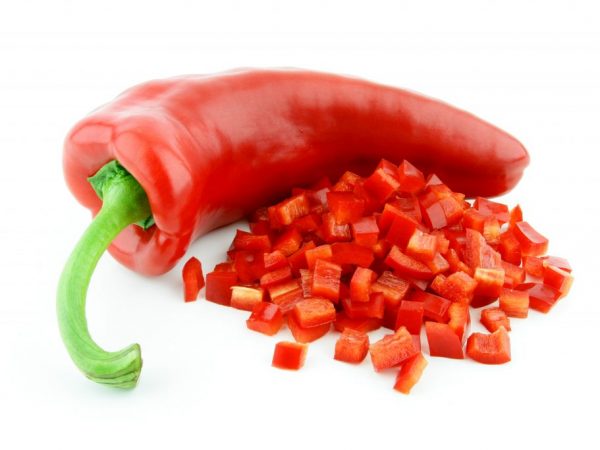

Delicious pepper
After the appearance of the first pair of leaves, the seedlings are transplanted to a permanent growing site. It is better to use areas where pumpkins, cabbage or legumes were previously grown. It is not recommended to use tomato plots: such land has become depleted in useful microelements. The distance between the rows should be about 70 cm, and between the holes - 50 cm.
Variety care
Pepper seedlings are grown at temperatures from + 18 ° C to + 25 ° C and regular watering.
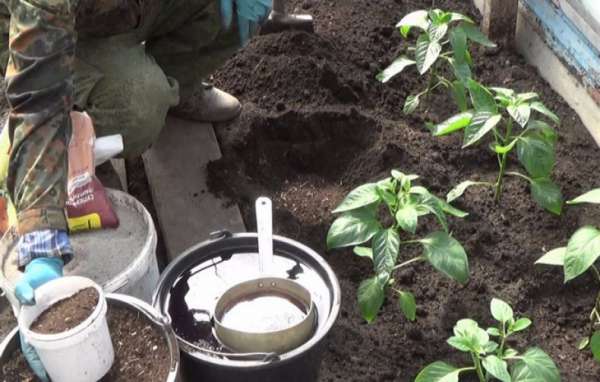

The bushes planted in the garden must be loosened and weeds removed. You need to water at least twice a week: before flowering - on top of the bushes by rain, and after - only at the root.
The water should not be too cold.
To obtain larger fruits and a larger yield, the soil must be repeatedly fertilized twice with manure, compost, phosphates or chicken droppings.
It is better to remove stepchildren - then the fruits will be larger. If the "Cow's Ear" pepper is grown in a greenhouse, it is necessary to periodically ventilate it to prevent the occurrence of condensation, which leads to falling flowers.
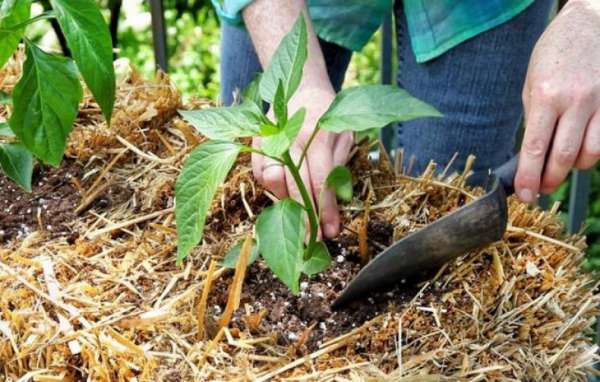

Too high or low temperatures can be detrimental to the bushes. Treatments with insecticides in case of the appearance of unwanted insects will not be superfluous. When these recommendations are followed, the bushes will bear fruit until the very end of summer.
Tips for growing peppers Ox's ear
Like most other varieties, Cow's ear is grown using seedlings. The process begins in mid-March. Summer residents are advised to use the land from the garden, where pepper will subsequently grow. This culture does not like transplants and does not always successfully take root in new soil, so this way you will reduce stress. Although the technology also allows the use of ordinary universal soil from the store.
Growing seedlings requires the following actions:
- Sort out the seeds. To do this, immerse them in water for a few minutes. You need to use the ones that will sink to the bottom.
- Soak the seeds for several days.
- Treat them with a solution of potassium permanganate.
- Rinse with warm water.
- After planting in the box, cover the seeds with foil. Due to a dislike for transplanting, it is impossible to dive seedlings. It is better to immediately plant seeds in small containers, 2-3 plants in each.
- Thin the seedlings, leaving only strong shoots. At the beginning of May, the pepper is ready for transplanting into a greenhouse, a little later - into open soil.
Find a warm, sunny spot for your peppers. If the crop will grow in a greenhouse, ventilate it regularly. Otherwise, the risk of shedding of ovaries and flowers increases. Watering the Ox's ear should be done at least twice a week, at the rate of 1-2 liters of water per bush. The principle is this:
- before flowering - the rain method;
- after the beginning and until the end of fruiting - watering at the root.
Make sure that the soil remains loose and that the bush is not clogged with weeds. You can mulch a bed of pepper. Feed your plants with superphosphate, slurry, or poultry droppings. The variety is well resistant to tobacco mosaic pathogens and some other diseases. If you follow agricultural techniques, the Volovye ear will delight you with fresh sweet fruits until the end of September.
Diseases and pests
"Cow's ear" is resistant to diseases such as verticillosis and phytoplasmosis. It can be affected by pests such as:
- aphid. It is necessary to treat with insecticides;
- Colorado beetle. Sprayed with celandine tincture;
- slugs are naked. They need to be destroyed, and the plants should be sprinkled with tobacco dust. Sprinkle mustard around the plant;
- spider mite. A solution of tincture of garlic and onion with the addition of liquid soap will help.
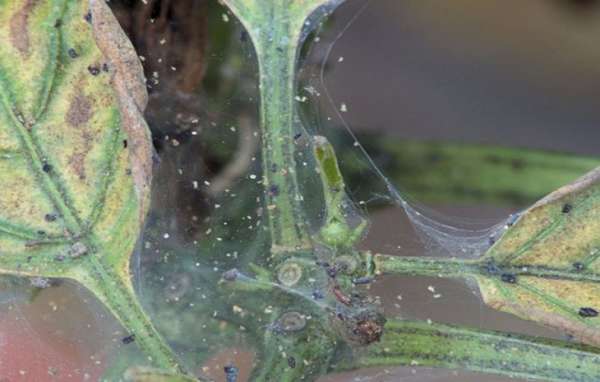

Sweet peppers of the "Volovye Ukho" variety are one of the leaders in terms of reviews and recommendations among summer residents and gardeners. Since this variety is ideal for growing in our latitudes, this pepper will delight you every year with its taste and amount of harvest.
My family is very fond of lecho, so I try to grow the largest-fruited and juicy peppers. It is also important that the walls of each fruit are thick, otherwise the pepper will fall apart during harvesting. I tried many varieties, settled on the Volovy ear. This is the pepper that I grew last year, I grow this year, and I will also buy it in the future.
General description of the variety
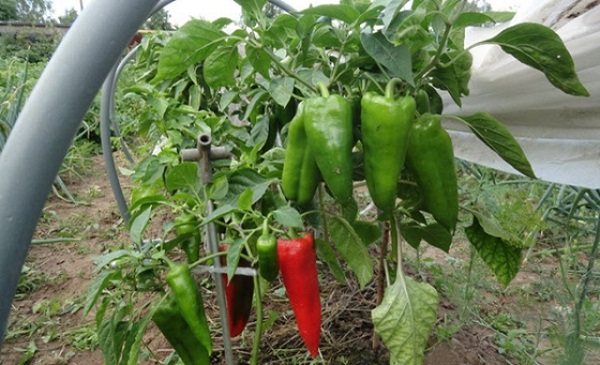

This is sweet pepper (sometimes they write “paprika” on the packages, it's the same thing).
By the type of ripening, it is mid-season. From planting seedlings to collecting the first fruits, it takes about 73 days.
The fruits are red, elongated, widened at the base and with a narrow tip. The average length is 12 cm (at 150 g of weight), but if the region is warm and care is good, the peppers grow up to 20 cm and 220 g, respectively. They are very juicy and fleshy.
The virtues of this culture
- The height of the bush is a maximum of 70 cm. That is, the variety is universal in terms of cultivation: it will grow equally well both in the open field or under a film cover, and in a greenhouse, a greenhouse.
- These peppers tolerate transportation well, so they are suitable for both summer residents and farmers.
- The fruits are well kept. Which, again, is convenient for summer residents: the crop can be harvested, folded in a pantry or basement, and at the end of the week taken to the city and already there, in a convenient and familiar kitchen, to process it.
- The variety is resistant to viral diseases (including tobacco mosaic).
- You can grow this pepper all over the country, without looking at the region.
- Each bush produces 2 to 3 kg of fruit per season.
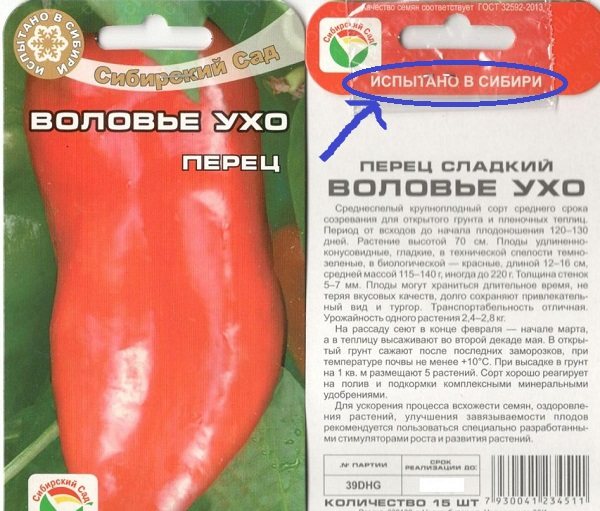

It is also important that the seeds of this pepper are produced by many agricultural firms. That is, you can buy seeds grown in your region (which is very important for successful cultivation).
Does this pepper have any drawbacks?
Every variety has them. But in relation to the Ox's ear, these are not weaknesses, but rather gardener's nit-picking ...
- The bushes of this pepper are spreading, so they take up a lot of space in the garden. If you make an interval between them less than 50 cm, they can start jamming each other.
- If in the southern regions pepper seeds can be sown directly into the soil of the garden bed, then in the middle lane and in the northern regions, exclusively the seedling method is suitable.
A gardener who has grown a whole bed of Ox's Ear will tell in more detail about this pepper. He will show her in his video:
Growing pepper from seeds
You need to buy and sow seeds for seedlings for 3-4 weeks of February. Do you live in the South? In this case, do not rush: seeds are sown in open ground at the end of May. At the same time, the soil temperature should approach 20 degrees (at night the earth may cool slightly, but be at least 15 degrees).
When calculating the number of future seedlings, remember: if the seeds are collected in your own garden and are fresh, germination can be 100%. But with purchased seeds, everything is not so good, their germination rate is often about 50%. Consider this when buying seed.
Seedlings are grown like this:
- Cover the seeds with water. Throw away everything that comes up - this is a marriage that will not germinate. Leftover seeds can be left in water for 1-2 days.
- Now briefly soak the seeds in a solution of potassium permanganate or aloe juice - this is disinfection. After that, they should be rinsed with warm water.
- Fill the boxes with soil from your vegetable garden (the same in which adult peppers will subsequently grow). It should be fluffed a little, adding sand, and also fertilized with ash. If at the moment you are in the city, and your vegetable garden is located in the village, you can buy ordinary universal soil.
- "Seal" the top of the box with a piece of plastic, keep the seeds at 25 degrees.
- When the seedlings grow 2-4 true leaves, it should be dived into separate containers. She does not tolerate this procedure very well, so be extremely careful and use only the transfer method. In addition, plants can be spilled with rooting solution after transplanting.
To completely abandon the picking, you can immediately use individual containers. Plant 3 seeds here. After waiting for a bunch of real leaves, sort out the seedlings, leaving the strongest shoots, and pinch off the weak ones.
Caring for growing seedlings is simple: protect them from direct sunlight and the formation of condensation on the leaves, water with lukewarm water.
Planting seedlings in open ground or greenhouse
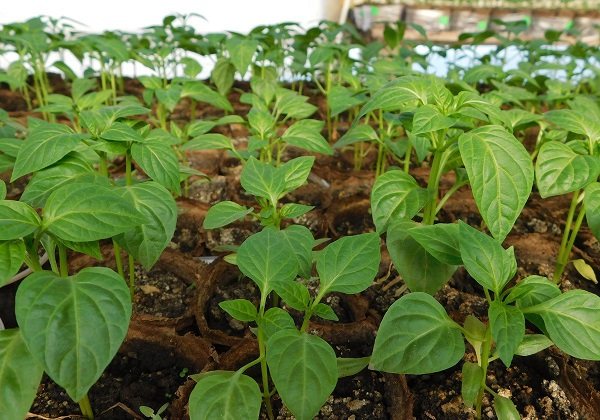

Temper young peppers shortly before planting in the ground, putting them out on the street, veranda or balcony for a short time every day.
Poor precursors for pepper: potatoes and tomatoes (these "guys" so "eat" the soil that the poor pepper has nothing left in it). If you have no choice and you have to grow Ox's ear right after the tomatoes, at least generously fertilize the soil with organic matter in the fall. Good predecessors: turnips, cabbage, cucumbers, legumes, and green manure crops.
Important! Avoid growing tomatoes and potatoes near bell peppers. In addition, do not plant hot (bitter) peppers in the same bed with it. Crops will become pollinated, and as a result, the fruits of all bushes will turn out to be sharp-bitter.
Disembarkation time: late May - early June. Such bushes will begin to bear fruit from the last week of July, and if yours is chilly, then at the beginning of August.
Add compost or humus to each hole when planting.
Caring for a fruiting plant
- Illumination. The more light and heat the Ox ear gets, the better. However, it will be good if there is something high nearby (for example, corn), which will protect the bushes from the hot midday sun. Moreover, this culture does not like musty air. If you grow peppers in a greenhouse / greenhouse, ventilate more often, otherwise the bushes will start dropping ovaries.
- Watering. Use only warm water. We pump it from the well, so first we collect a large vat, which heats in the sun all day, and in the evening we spread the water with a watering can. You need to water the Cow's ear about 2 times a week (if it is very hot outside, then more often). Important! While the seedlings are not blooming, you can water the bushes from a watering can with a diffuser ("rain"). As soon as flowers appear, the diffuser must be unscrewed, directing the water with a stream strictly under the stem. One bush drinks about 1.5 liters at a time.
- "Manual therapy". Like any crop, peppers need to remove weeds and loosen the soil. Or you can go the other way: even during planting, mulch the garden, and stop there.
- Top dressing. Both organic matter (especially slurry or chicken droppings) and mineral compositions are suitable for pepper. Superphosphate has also worked well. It is worth feeding the peppers three times: 2 weeks after planting the seedlings, at the beginning of flowering and when the peppers begin to turn red.
- Pests. Colorado beetles, slugs, spider mites and aphids will eat with pleasure. Moreover, these scoundrels attack more often when the peppers are already tied up and it is impossible to spray them with something purchased. We'll have to apply "traditional medicine". Colorado can be chased away with celandine tincture, against slugs, all the bushes can be covered with tobacco dust (plus the ground between them - mustard), and the spider mite is afraid of soapy water, as well as onion or garlic tincture.
There are many tricks of growing pepper. And then there are the often repeated mistakes that make even the best varieties bear fruit very badly. This video will help prevent them:
Reviews of gardeners
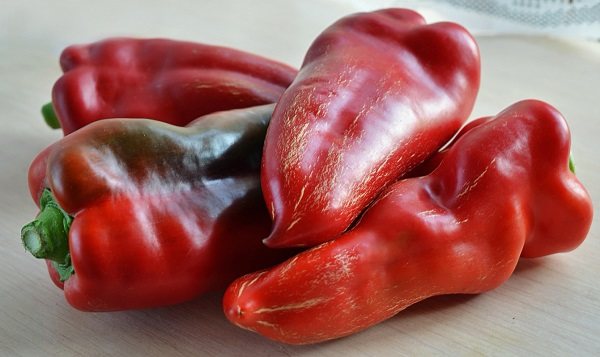

Before buying and sprouting these seeds, I heard a lot about them. The neighbors said that the Volovye ear is a variety that is not bad in terms of yield, which will consistently give birth generously in the garden, and even better in the greenhouse. Great for salads, super sweet.
If you do not pluck the fruits when they only turn red, but let them grow a little, they will increase even more in size and become wet. The largest peppers on the bushes are the ones that started first. Further they will grow smaller and smaller. And the very last, September fruits, due to their small dimensions, are used for stuffing.
Having received the first harvest, I realized - I will grow the variety next year too!
Here's what I liked:
- when harvesting, it is very convenient to clean, there are almost no seeds and partitions inside;
- if you hurry and pick slightly unripe fruits, they still won't taste bitter;
- the harvest of pepper is very rich, the bushes are simply hung with fruits;
- if I do not have time for care (frequent watering, top dressing), the harvest is still good;
- for all the time, pepper has never hurt me.
Having prepared a lot of lecho and other salads, I freeze the remaining pepper. I just clean it from seeds, cut it into strips of different thickness, put it in special bags, and in the freezer. In winter, such pieces are used in borscht, in sauté or risotto (wide strips), and in pizza (narrow strips). I highly recommend this method of harvesting!
- Cow's ear is a mid-season sweet pepper variety. It is appreciated for its thick, juicy fruit walls, delicious taste and excellent yield.
- When buying seeds, it is important to find a grower that works in your area. The same variety, but grown in a warm area, in Siberia will give a weak harvest.
- This crop can be grown both in the open field and in a greenhouse.
But you won't grow the same variety, right? I offer a video review of the top ten varieties of sweet peppers. In addition to the Ox Ear, there are Gogoshary, Lesya and other proven options here:
Sweet pepper in terms of consumption by the population is in the top three along with tomatoes and cucumbers, but, compared with them, the agricultural technology of its cultivation is somewhat more complicated. Pepper Volovye ear, bred by domestic breeders, has an outstanding taste against the background of "glass" imported hybrids. We will acquaint the gardener with this variety, its features and secrets of agricultural technology.
Growing recommendations
Sweet peppers of this variety are grown through seedlings. They begin to cook it in mid-March.
This technique will allow young plants to immediately accustom themselves to the soil where they will have to grow, thereby minimizing the stress from transplanting.
The process of preparing seeds for seedlings of the Volovye Ukho variety includes several stages:
- Selection of live seeds. To do this, all the seeds are immersed in water, and the floating dummy seeds are selected. They do not contain a sprout, so you should not plant them.
- Soaking the seeds for several days.
- Treatment of seeds with a weak solution of potassium permanganate, followed by washing them with warm water.
Seeds that have undergone such training will be able to sprout faster, and will already have a certain immunity. They are planted in a pre-prepared substrate, after which they are covered with a film until shoots appear.
Therefore, it is better to plant seeds in separate containers, 2-3 pieces each. After emergence, weak shoots must be removed, leaving one strong one.
Ready-made vegetable seedlings of this variety can be planted both in open beds and in a greenhouse. When disembarking, it should be borne in mind that the best predecessors will be:
- siderates;
- legumes;
- cucumbers;
- all cruciferous plants and others.
It is not recommended to plant seedlings of the Volovye Ukho variety after tomatoes. And if there are no other options, then in the fall you need to dig up the ground with any organic fertilizer.
Otherwise, the requirements for the care of this variety are the same as for all peppers:
- Lots of light and warmth. Moreover, if the peppers are planted in a greenhouse, then airing is necessary. If this is not done, then the flowers and ovaries will crumble from the plants.
- Watering with warm water. Watering frequency depends on weather conditions, but not less than 2 waterings per week. Before flowering, rain watering is preferable, and from the beginning of flowering to the end of the growing season only at the root. The rate is from 1 to 2 liters of water per plant.
- Regular loosening and weeding. You can skip this step of leaving if you mulch the bed with pepper plants.
- Top dressing with mineral and organic fertilizers. Good results are obtained by using poultry manure, slurry, and superphosphate.
If these recommendations are followed, the Volovye Ear variety will bear fruit abundantly until the end of September.
Read also: Planting peppers in the ground with seedlings: when and how to plant, care after planting
More information about growing sweet peppers can be found in the video:
Description of the Volovye Ukho pepper variety
This variety is quite popular in Russia, it is known, loved, consumed and grown in all its regions. He received permission to grow in 2007, when he was entered in the State Register. The originator was the well-known Agrofirma Poisk, which is the author of the variety. The authors recommend growing this pepper in the open field and under film shelters in personal subsidiary plots.
The cow's ear belongs to the mid-season varieties. The fruits reach technical maturity in 90-100 days after full germination, and they fully ripen and color in about a month (120-130 days in total). The variety does not shine with yield - under film shelters it is only 3.2 kg / m 2 (according to the State Register). True, some sellers of seeds (for example) indicate on the packages that the yield of the variety is 2.4-2.8 kg per bush, which, with a planting density of 5 plants per square meter, will be 12-14 kg / m 2. The available reviews of gardeners do not contain information about the yield, so you can only find out what it really is by experience.
The variety is resistant to fusarium and other diseases. According to gardeners, it is susceptible to attack by pests - aphids, spider mites, Colorado potato beetles, but for some reason slugs bypass it. Poorly tolerates sudden temperature fluctuations and cold snaps.
Appearance
Spreading pepper bushes, medium height (60-70 cm). The foliage is also medium, slightly wrinkled leaves have a dark green color. On each bush, usually 10-12 fruits are tied and grow.
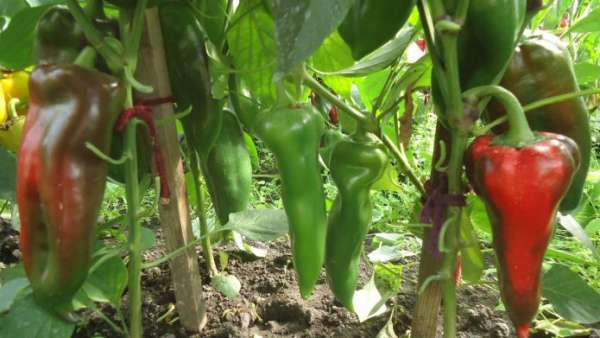

Pepper bushes Vovye ear sprawling, medium-leafy
Video: an overview of the pepper bushes Volovye ear
Characteristics and features of the cow's ear pepper
Pepper fruits are drooping, have a conical shape, flattened from the sides. The surface is highly glossy, corrugated. The average fruit weight is 170-200 g with a length of up to 16 cm and a wall thickness of 6.7 mm. The flattening of the pepper is due to the fact that inside it there are only two thin partitions that are not able to keep the shape of the fruit. This feature, as well as the low seed content, results in a very low cleaning waste. The color of the fruit in the state of technical maturity is green, and when fully ripe, it is deep red. The fruits have excellent taste, they are used fresh, in salads, culinary dishes. And also they are good in various blanks. Storage and transportability are excellent.
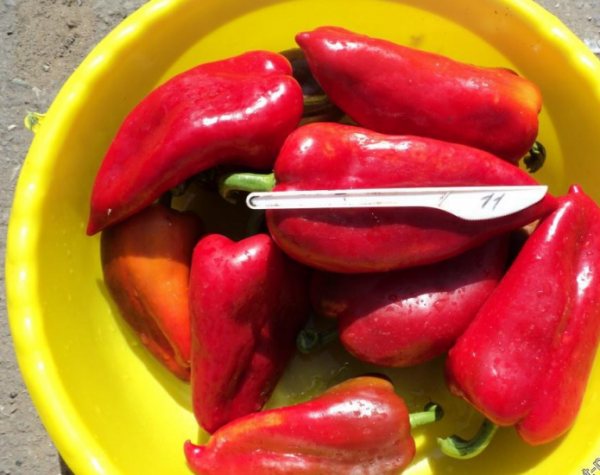

Fully ripe peppers have a deep red color.
Video: review of the fruits of the peppers Volovye ear
Table: the advantages and disadvantages of the Volovye ear variety
Characteristics and description
Pepper of this variety is universal.
Description of the bush
If you look at the photo of the "Cow's Ear" pepper, it immediately becomes clear that the variety got its name due to the shape of its fruits. The bush itself, on which the "ox ears" are located, is so sprawling that it resembles a huge head.
Medium to large leaf plate. The color is green and dark green, with slight wrinkles.
Description of the fetus
The variety belongs to large-fruited. Large, the size of a human palm, up to 20 cm long, and weighing from 170 to 200 g.
The shape of the hearth is also interesting, it can be described as a cone with bends. The general shape has a regular cone, but moving away from the place of attachment to the stalk and up to the very tip, the fruits bend smoothly. In this case, one bush can bear both completely "correct" fruits, and curved to the point of disgrace. The main part of the fruit has a beautiful bend in the center.
Bends appear on the peppers from the very moment they are tied. As they grow, they can straighten, form again, and appear in other places.
Unripe fruits are dark green in color.With the onset of ripening, redness appears, which is located longitudinally, starting from the attachment point, and gradually diverges downward.
At full biological maturity, the fruits have a rich red and dark red color. A strong gloss is inherent in both fruits in technical ripeness and fully ripe.
The taste of the fruit is pleasant, sweet, aromatic with a persistent aftertaste.
Yield
Based on the results of varietal tests, the variety was assigned a yield in the range of 3.2 kg per square meter.
However, vegetable growers who have already managed to grow pepper, describing the yield, say that each plant carries up to 10 pieces of excellent fruits whose average weight is within 150 g, or even more. Consequently, one plant produces a yield of up to 1.5 kg. If you plant three plants per square meter, then the yield should already be about 4.5 kg.
The main purpose of the variety
The fruits are recommended for fresh use, they are tasty and sweet. Peppers add flavor to any salad and make it unforgettable
The fruits are also suitable for culinary processing. They fit well in a skillet, and fried peppers with garlic sauce will amaze even a gourmet.
"Ox ears" are good for canning and pickling. Since the pepper is long, it will not fit whole in 0.5 liter cans, but it will look good in liter ones.
Peppers of this variety can also be stuffed. For this purpose, you can use both fresh fruits and frozen ones.
Growing features
Planting and caring for Volovye ear pepper occurs according to the usual rules for culture, taking into account some of the nuances due to the characteristics of the variety.
Peppers are always grown only in seedlings due to their too long ripening period. Due to the popularity of the Volovye ear pepper variety, its seeds are offered for sale by many manufacturers, among which there may be unscrupulous ones. Therefore, when choosing, you should give preference to well-known and proven trademarks, for example:
- "Search";
- "Aelita";
- "Plazmas";
- "Siberian Garden" and others.
Since the variety Volovye Ukho is not hybrid, its seeds can be successfully harvested on their own, selecting the best, fully ripe fruits for these purposes.
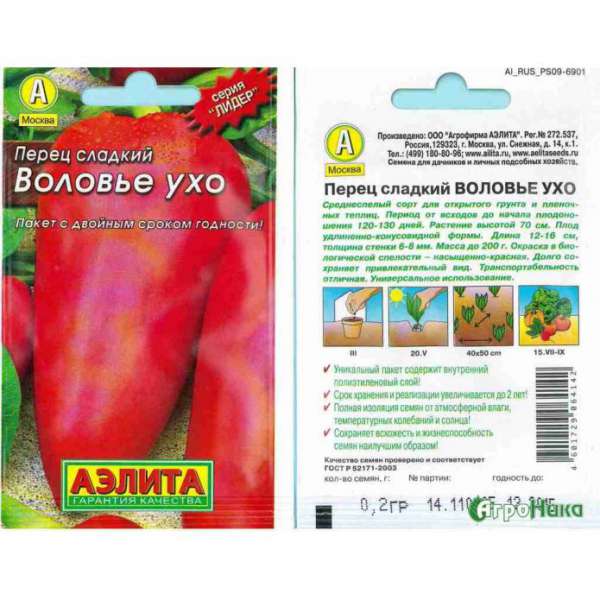

Agro is a proven seed producer
Producers recommend sowing seeds in late February - early March, and replanting seedlings in the greenhouse in mid-May. Peppers can be planted in open ground only when the threat of recurrent frosts has passed and the daytime temperature is at least + 10 ° C.
Pepper does not tolerate transplanting, so its seedlings should be grown in individual containers - pots, glasses (preferably peat), peat tablets.
It is most convenient to grow peppers in meter-wide beds in a two-line pattern with a row spacing of 50 cm. Small plants of this variety will grow well, supporting each other in a pair planting. In this case, the interval between pairs of plants should be 40-50 cm.
We focus on some important aspects of peppers care.
Formation
The variety does not need shaping and pinching. Only at the end of summer should all flowers and small ovaries be removed, since they will not have time to ripen and will slow down the ripening of large fruits, drawing off some of the nutrition.
They should be quite frequent, the soil should not be allowed to dry out. The usual interval between watering peppers is 1-2 days, but in extreme heat they are carried out daily. By equipping a drip irrigation system on the site, the gardener will significantly reduce the laboriousness of caring for peppers. Mulching the soil with straw, hay, sunflower husks, peat, etc. also contributes to a decrease in labor intensity. In this case, the intervals between watering and loosening will increase, and the growth of weeds will also decrease.
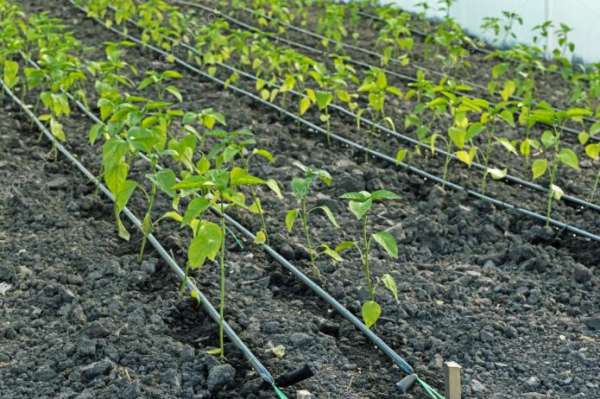

Drip irrigation of pepper significantly reduces maintenance labor costs
Producers of pepper seeds, Volovye Uto, report on the packaging that the variety is responsive to the application of complex mineral fertilizers. Therefore, it is recommended to purchase in advance such complexes that contain all the necessary list of trace elements in balanced doses. The methods and rules for their use are indicated on the packaging. At the same time, as with the choice of seeds, fertilizers should be purchased from well-known brands:
- Agricola;
- Agronomist Profi;
- Good power;
- Sudarushka;
- Blank slate and others.
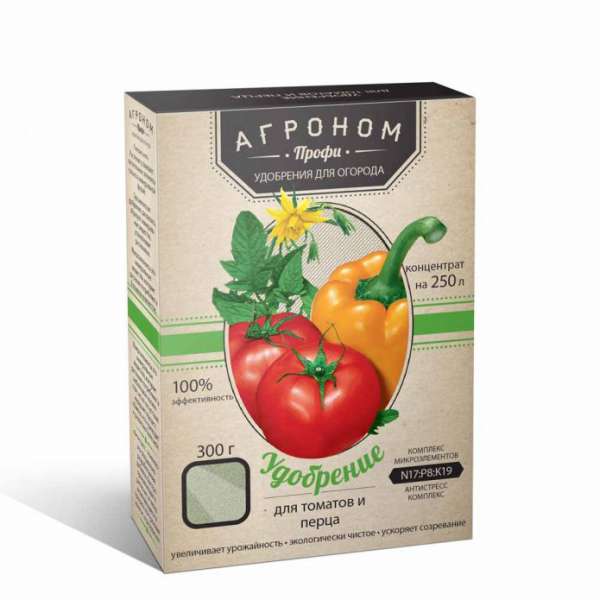

Complex mineral fertilizers contain all the elements necessary for peppers
Sun protection
In the southern and middle regions, periods of very intense heat often occur in summer. In such conditions, the growth of peppers is inhibited, leaves and fruits wither, get burns, the harvest is threatened. At this time, it is necessary to shade the plants, covering them with a shading net or the same spunbond that was used in spring for insulation. Since the height of the Pepper Bushes is small, ordinary arcs are well suited for this. If they were installed in the spring, then you just need to leave them for the summer and, in case of heat, use them for shelter.
Due to the immunity of the variety, it does not need treatments against diseases. For preventive purposes, it is possible (but not necessary) to apply spraying with Fitosporin M, since it will be beneficial for the plants in any case. This biological antifungal agent is at the same time a good foliar feeding, since it contains humic acids in its composition, which help to increase yields and strengthen immunity. It is not addictive to pathogens, it is not toxic, so it can be used without restriction (the recommended interval is 2-3 weeks), even during the harvest period.
It is better to fight possible pests with the use of various folk remedies or bioinsecticides (this is the name for biological preparations for pest control), for example:
- Fitoverm;
- Fitolavin;
- Iskra Bio and others.
When using drugs, you should follow the instructions on the packaging or in the attached leaflets.
Reviews of the Volovye ear variety
Mid-season large-fruited variety for open and closed ground. The plant is 70 cm high. Fruits are elongated-conical, smooth, in biological ripeness they are red, 12–16 cm long, with an average weight of 115–140 g, sometimes 220. Wall thickness 5–7 mm. I'll try.
OLGA
I liked the variety, it matches the description, the bushes were 50 cm and below, but covered with fruits of an interesting shape. The fruits are long, large, uneven, the tips were slightly bent and sticking out to the side, I called them mustachioed bushes. I liked the taste. Plus for the yield.
Olga-70-KAZ, northern Kazakhstan
Bovine ear. I liked the pepper, fruitful, tasty. I will plant more. The seeds were from.
azure, Don Territory
I liked the Volovye Ear too. The only thing he got hotter was at the end of July, but he started to mature on the bush. And so, quite a productive and tasty variety.
Firefly Plus
Cow's ear is a sweet pepper with excellent taste and consumer qualities. Growing it with due diligence is quite affordable for a gardener with little experience and a basic level of skills. The variety can definitely be recommended for cultivation both for personal consumption and for commercial purposes.
Sweet peppers are always popular with vegetable growers. Pepper Volovye Ear is a variety that is increasingly grown in garden beds and greenhouses. The benefits of pepper fruits are widely known, so gardeners will always find a place on the plot for seedlings of this vegetable crop.
Variety history
Agro was registered in the Moscow region in 1990. The company is engaged in creating and growing improved varieties of vegetables adapted to the Russian climate with more pronounced taste qualities.
One of the tasks of the company's breeders was to create a sweet pepper variety that surpasses foreign counterparts in taste and vitality.
The pride of the breeders of "Search" became the variety of sweet bell peppers they created - Volovye Ukho. In 2007, it was included in the State Register with admission to growing in any Russian climatic zone.
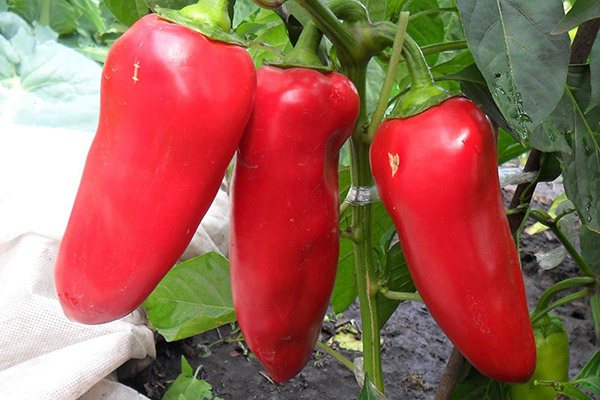

Description and main characteristics of the variety
Why has Volovye Uho been one of the most popular varieties for more than one season? What characteristics are attractive to growers, despite the fact that caring for this vegetable crop is not as easy as for tomatoes or cabbage?
It turns out that the dense and large fruits of this variety contain a large amount of vitamin C and other active substances. The peppers are sweet and crunchy and therefore enhance the flavor of any fresh salad or other dish.
The description of the variety should begin with the maturation of the crop. Volovye Ukho is an excellent mid-ripening variety: from the moment of the emergence of friendly shoots to the technical ripeness of the fruits, a little more than 3 months pass, and the full ripeness of the harvest can be expected in 4 months. The variety is intended for cultivation in open ground and in unheated greenhouses.
The bushes are medium in size, the shoots do not grow higher than 65 - 70 cm. The bushes are spreading in width - at least 30 cm in radius, therefore it is not recommended to plant the seedlings of the Ox Ear on the beds closer than 0.5 m from each other.
Shoots are erect, well-branched, strong enough, up to 0.7 m in height, average foliage. The foliage is dense, simple, of medium size, the edges are slightly wavy, the color is dark emerald. The upper side of the leaves is slightly glossy.
Due to the rather voluminous foliage, Volovye Ukho does not tolerate the hot season poorly. If the pepper is planted in a greenhouse, condensation will settle on the leaves, which negatively affects the plants.
Ripe peppers are shaped like ox ears (which is why they got this name) - elongated, cone-like, slightly corrugated. Their length can reach 15 - 16 cm. Unripe fruits are green, and in the stage of full maturity they become bright red with a raspberry tinge.
The peppers are fleshy, sweet and juicy, with a wall thickness of about 7 mm. The average weight of peppers is 130 - 145 g, but with good care, large fruits can be grown - up to 200 - 240 g in weight. The yield per bush is usually 2.5 - 3.2 kg. The commercial qualities of the ripe crop are high. It does not always make sense to wait until the whole crop is ripe, because the fruits at the stage of technical maturity after harvesting ripen perfectly in a cool room.
The characteristic of Volovye Ear pepper will be incomplete without a story about immunity to diseases and keeping quality. The resistance of this variety to the main diseases and pests is average. Due to the rather dense walls, ripe peppers are perfectly stored in a cool place, preserving their presentation and good taste. The harvested crop tolerates transportation well over long distances.
Ripe peppers are universal: the fruits of this variety are consumed fresh, added to salads, suitable for preservation (especially in lecho).
Growing and care
Bell's ear sweet pepper is grown through seedlings both for planting in open ground and for greenhouses. Sowing of seeds can be carried out from March. The exact time should be chosen depending on the weather forecast for the period of planting plants in a permanent place.
The ground for peppers must be selected according to the following requirements:
- saturation with nutrients;
- neutral acidity;
- high permeability to water and air.
Caring for a vegetable in the beds includes not only regular watering, but the obligatory introduction of top dressing, removal of weeds, prevention of diseases, and prevention of pests.
Seed preparation and sowing
Planting seeds should start with the selection of soil mixture for seedlings and a shallow container.In addition, you can use peat pots with a substrate, then Volovye's ear can be grown without further picking.
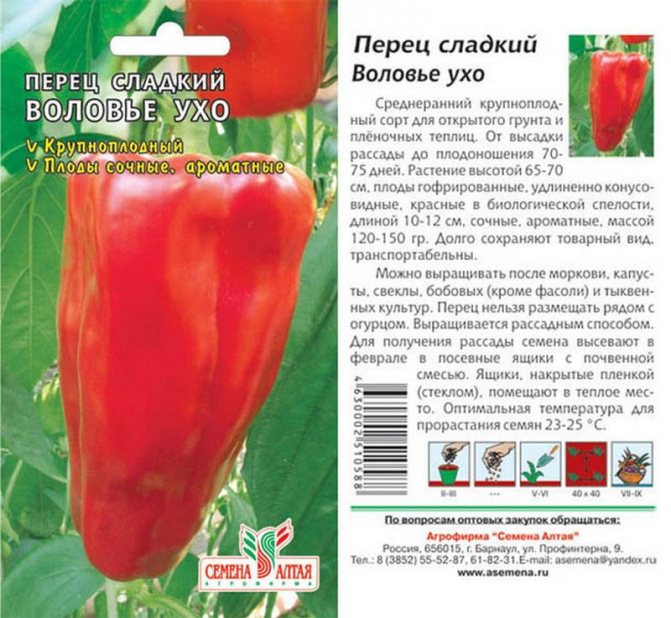

When buying seeds, you need to carefully evaluate the shelf life, based on the dates of collection and packaging of planting material.
The seeds must first be checked for germination. For this, a small container is filled with brackish water, into which the seed is immersed. Seeds that have completely sunk to the bottom are considered suitable.
Then disinfection is carried out by a half-hour treatment with a weak solution of potassium permanganate.
The seeds germinate between layers of damp film-wrapped tissue under the influence of heat for 1-1.5 weeks.
Planting seeds is carried out as follows:
- The container is filled with soil just above the middle.
- The soil is wetted with water.
- Germinated seeds are placed on the surface.
- The earth is poured on top with a layer of up to 2 cm.
Seedlings should be placed in a warm place with a diffused light source. It is important to water it with warm water, and also avoid moisture getting on the leaves.
Picking
Not the highest germination of seeds of the Ox's ear leads to the fact that preference is given to growing seedlings with subsequent picking. In this case, the seed is placed on the ground more closely, but at a greater distance from each other.
Careful care of the seedlings guarantees intensive growth, which requires observing the temperature regime and keeping the soil sufficiently moist.
It is advisable to carry out a dive of the Ox's ear as early as possible. Young growth tolerates the procedure better.
To transplant seedlings into separate containers, it is enough to wait for the first pair of true leaves to appear. For each plant, the vegetation rate is different, but on average, the Volovye's ear reaches the right moment for picking after 14-20 days.
The vegetable does not tolerate the procedure, which negatively affects the growth rate, therefore it is recommended to do without thinning or transplanting seedlings.
Planting seedlings in the ground
The time of planting in a permanent place depends on the weather conditions of the area and the type of cultivation chosen. In southern Russia, the variety can be planted in May; in mid and northern latitudes, it is better to postpone the procedure until early June. For full growth, the following conditions must be met:
- optimum ambient temperature 18 ° С;
- high air humidity;
- good illumination;
- nutrient-rich soil.
If the climatic conditions of the region do not meet the necessary conditions, it is recommended to grow the cow's ear in a closed ground.
When planting a vegetable, it is worth considering what crops grew on the site last season. You can not plant seedlings after tomatoes and potatoes, or in the immediate vicinity of these plants, and hot pepper. It is preferable to plant Volovye's ear in the place where there were earlier plantings:
- cabbage;
- legumes;
- cucumbers;
- turnips;
- siderates.
The beds for the Ox's ear are formed in such a way that in the future the bushes do not create a shadow for each other. It is recommended to place the rows at a distance of at least 0.6 m, and the plants no closer than 40 cm from each other.
The depth of the holes should correspond to the level of the root collar of the seedlings. In order not to damage the roots, it is worth replanting the Volovye ear using the transshipment method.
The planting pits are filled with moist, nutritious soil mixture with the addition of a small amount of sand. If the plants have a weak stem, additional support pegs can be installed.
Watering and feeding
Pepper crops need constant soil moisture for normal vegetation. Water for irrigation must be warm and settled for several hours.
It is enough to water the seedlings of the Ox's ear after transplantation 2 times a week. During hot dry weather, the soil should be moistened weekly. It is better to apply water by sprinkling so that moisture does not get on the leaves.
After irrigation, a crust may form on the soil, which will prevent the saturation of the soil with oxygen, so the soil must be loosened after moistening.
Sweet bell peppers need a lot of nutrients. A cow's ear will not bear fruit normally on poor soils. Bushes require organic matter, as well as phosphorus fertilizers.
Top dressing should be carried out according to the following scheme:
- 14 days after planting, you can add organic matter or ammonium nitrate.
- Superphosphate is recommended during flowering.
- In the period between the onset of technical and biological maturity, you can add some complex fertilizers.
Diseases and pests
The Volovye ear variety of pepper is immune to most diseases to which other varieties of the culture are prone. Conditions such as:
- early landing;
- violation of watering norms;
- exposure to pests.
These factors provoke diseases such as phytoplasmosis, tracheomycosis (fusarium), and verticillosis. First of all, decay of the root system begins, leading to lethargy of the shoots and the gradual death of the culture.
For the prevention of diseases, the cow's ear should be treated with antifungal drugs, for example, Fitosporin M.
Among the pests dangerous for sweet peppers can be:
- Colorado beetle;
- spider mite;
- aphid;
- naked slugs.
Getting rid of snails and slugs is easier. To do this, it is enough to treat the Volovye's ear with tobacco dust or dry mustard. Among folk remedies against insects, infusion of garlic, onion husks and celandine is actively used.
A reliable way is to use chemical or biological preparations (Fitolavin, Fitoverm, Iskra Bio).
Advantages and disadvantages of the variety
The undoubted advantages include:
- high productivity;
- good commercial qualities of the ripened crop;
- excellent taste;
- the versatility of ripe fruits;
- the crop can be kept fresh for a long time, retains valuable properties when frozen for a long time.
There are also disadvantages of this variety of pepper:
- bushes do not tolerate heat well;
- destructive condensate settling on foliage in a greenhouse.
Volovye Ear is demanding to care for, otherwise it is difficult to get high-quality fruits.
Reviews of gardeners
The Volovye ear variety is widely known to gardeners in any region of the Russian Federation. It is loved very much for its unique taste and versatility in application.
Garden owners and farmers who are professionally involved in growing vegetables note that the peppers they have grown, the Volovye ear, correspond to the description of the variety given by the manufacturer. Farmers are pleased with the high yield, decent taste, aroma of fruits, their ability to be stored for a long time and can easily be transported.
Thus, we can conclude that some capriciousness of the variety to the growing conditions is insignificant in comparison with a number of its pronounced advantages.

